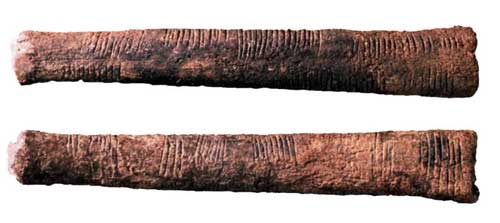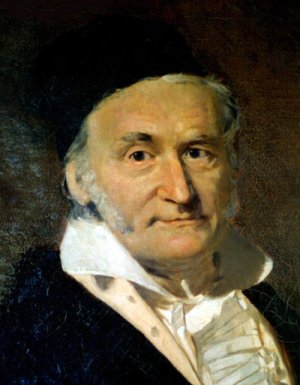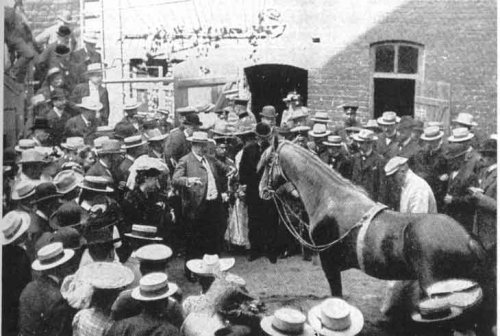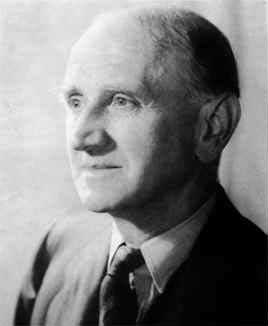
The death of the lightning calculator
This is a runner-up of the schools category of the Plus new writers award 2006.
On stage in a school auditorium in Lyons, France, stands a diminutive, bespectacled Dutchman, Wim Klein. In the audience are 200 scientists and mathematicians who have given Klein a 200-digit number scrawled across eight blackboards. The test: to extract, without pencil, paper or machinery, the twenty-third root of that number in the shortest possible time. Suddenly, the clock hands above the blackboards begin turning. Klein looks at the number, then paces the stage, furiously muttering to himself in Dutch. The audience watches breathlessly as the clock moves on — five minutes ... eight ... ten. At exactly 10 minutes 30 seconds, Klein takes a piece of chalk and writes a large number on the board.
From the Readers Digest article Meet the Human computer by Samuel Shreiner.
The beginnings
Arithmetic is possibly the most-used tool in life. It is more important than the five senses, since counting is the bedrock of most modern day activities — whether in the form of binary commands controlling a computer, or a host checking that there are sufficient cocktail sausages for his guests. Numbers form an essential part of our day to day lives.
Archaeologists inform us that the earliest forms of arithmetic were developed in Africa, circa 18,000 BC, with the advent of the Ishango Bone. Fortunately mathematics has developed considerably since this primitive technique was disposed of. Much of the mathematics that we use today is based on the discoveries of ancient civilizations, and in particular the Greeks. Living in a practical world, the discoveries of Greek, Babylonian, and Egyptian mathematicians were suitable for application, and were used for practical purposes.

The oldest calculator on the planet? The front and back of the Ishango bone. Image courtesy the Museum of Natural Sciences in Brussels.
It is often noted that the reason we count in base ten is because we have ten fingers and ten toes. Holding up two fingers can represent two beans; when two more beans are sighted, by putting up another two fingers we deduce that there are four beans. This should be simple ... for most of us.
Blackadder: Let's try again. If I have two beans, and then I add two more beans, what does that make?
Baldrick: Umm ... a very small casserole? 1With the numbers and counting in place, the stage was set for modern day arithmetic to take over. The world truly became the mathematicians' metaphorical oyster. With this history in mind, I intend to bring to light the little known art of lightning arithmetic: the extraordinary ability of some people in mental arithmetic.
The birth of mental calculation

Human lightning calculators: no need for props.
The first documented rapid arithmetician was Jedediah Buxton (1707-1772), a farm labourer from Derbyshire. Buxton never learnt to read or write, neglecting all opportunities of education, and seemed to have no ambition at all. If he had lived in the 20th century he would have been considered autistic, but in his time such disabilities were not recognised, instead he was considered stupid.
In his youth, Buxton's mathematical abilities were prevalent in his counting, rather than computing. Instead of putting this to use, he simply took pride in impressing friends. During one trip to London, to be tested by the Royal Society, he had enough time to go see David Garrick performing in Richard III at the Drury Lane Theatre. At the conclusion of the performance, Buxton was able to tell his companions that a total of 14,445 words had been spoken, and that the actors took a total of 5,202 steps. Unlike Richard III who thought he "saw a thousand fearful wracks; A thousand men that fishes gnawed upon."2, Buxton was almost always exact in his calculations, and there was certainly never any ambiguity!
Possibly more remarkable than Buxton's tale, is the story of African born Thomas Fuller (1710-1790), only three years younger than the former, and from a completely different cultural background. Fuller, like Buxton, had difficulty learning and was never able to read or write. At the age of fourteen he was captured and exported as a slave to Virginia, USA. A typical question asked of Fuller would be:
"On being asked how many seconds a man has lived who is 70 years, 17 days and 12 hours old, he answered in a minute and a half: 2 210 500 800. One of the gentlemen who employed himself with his pen in making these calculations told him he was wrong, and the sum was not so great as he had said — upon which the old man hastily replied: stop, master, you forget the leap year. On adding the amount of the seconds of the leap years the amount of the whole in both their sums agreed exactly.3"
Like the story of Jakow Trachtenberg, which will be discussed later, I propose that much of Fuller's talent in manipulating numbers came from the hours he would have spent alone as a labourer, especially on the long journey from Africa to America.
So far the examples of calculators suggest that it was only the under-educated that could perform such rapid mathematics; was this the case?
"Father the Reckoning is Wrong"

Carl Friedrich Gauss, 1777 - 1855.
Supposedly said by the eminent mathematician Carl Friedrich Gauss (1777-1855) when, at the age of three, he was correcting his father's work. Gauss also claimed that he was able to calculate before he could talk. While this sounds absurd, psychologist D.C. Geary's research suggests that it could be possible: he argues that we have a pan-human capacity for arithmetic, which guides us through counting before we can use number words.
Gauss was not the only educated calculator. The first of the stage calculators fortuitously coincided with the famous American Vaudeville theatre era. At the age of six, Zerah Colburn (1804-40) became the first of the great international calculators. During one performance a woman said to Colburn, "About twenty years ago, I lost some silver spoons; I suspect they were stolen. I want you to tell who has got them," the child quickly returned that he was "neither prophet nor conjuror". This example proves how hard it was to categorize the stage computer: neither fraudulent (although there were some cheats, few reached such acclaim as the genuine performers), nor paranormal: his skills are those developed with excessive practice and work.
Although not exactly rapid, there was another mathematician drawing crowds in the 19th Century. Hans Von Osten was an Arabian stallion bought by Wilhelm Von Osten in 1888. Before Hans, Wilhelm had tutored a cat and a bear in addition. When both attempts failed, he tried a horse! Anthropologist Phyllis Lee's research reveals the intelligence of animals through studying their ability to count (according to Lee, iguanas can count to three), but Hans was doing more than counting. Someone would ask a simple arithmetic question — for example What's 7 times 4? — and they would then start counting aloud. When they reached 28 the horse would start stamping its hooves.

Clever Hans performing.
A panel of scientists — The Hans Commission — led by Carl Stumpf, was asked to conduct research into the horse's ability. When they struggled to find a reason, the responsibility was passed to Oskar Pfungst, another psychologist. After a series of tests Pfungst concluded that the horse was neither doing mathematics, nor involved in fraud: Hans was reading subconscious messages! When the questioner was counting, he would emit subtle subconscious signals as the answer was reached, Hans recognised these, and responded accordingly. Hans's case study is now infamous, with the generalised case of his ability now named after him: the Clever Hans Effect.
The twentieth century
With the changing times, the number of lightning calculators reduced. Jakow Trachtenberg (1888-1953) led an unsettled life. In 1919 he discovered that Russian revolutionaries intended to kill him, and fled to Germany. But with the coming of Hitler, Trachtenberg again had to take cover as he spoke out against fascism. He fled a second time, now to Vienna. When the Germans marched on Austria, he was forced to escape to Yugoslavia, but this freedom was not to last long. He was awoken one night by the Gestapo pounding on his door, and a few days later he was in a concentration camp.
To retain his sanity, Trachtenberg would visualise large numbers. He had nothing to write with, and so spent his time developing a new system of mental arithmetic. When he escaped from the camp in 1945 he started teaching his system to others. In 1950 Trachtenberg founded the Mathematical Institute in Zurich, where he taught under-achieving children to do outstanding arithmetic: "A small girl with beribboned braids was asked to find the solution of 735352314 times 11. She came up with the correct answer — 8088875454 — in less time than you can say multiplication table."5

Alexander Craig Aitken, 1895 - 1967.
Trachtenberg was not the only mathematician involved in the war. Alexander Craig Aitken (1895-1967), retired from service after an injury in the World War I. Later in life, as well as being able to recall Pi to 1000 digits (the first man to do so), he was able to recount the regimental numbers and home addresses of all the members of his platoon. Nor was he limited to mathematics: additionally he was a skilled violinist, and was elected to the Royal Society of Literature in 1964, on the publication of his war memoirs.
The end for lightning calculators?
While it is a rather incomplete history of mental calculators, I chose this selection for its contrast. In studying why the art has declined it is important to look at the whole variety of different exponents. The first two studies, of Buxton and Fuller, were of sufferers from undiagnosed savantism. A similar case of autism resulting in exceptional numeric abilities is documented by the neurologist Oliver Sacks. George and Michael (1943- ) are twins, both suffering from autism. Sacks relates that on one occasion he found them whispering long, eight digit numbers to each other. Sacks wrote them down, but they appeared to be completely random. Further inspection showed, however, that they were conversing entirely in prime numbers. As Sacks goes on to say:
"They do not approach numbers lightly, as most calculators do. They are not interested in, have no capacity for, cannot comprehend, calculations. They are, rather, serene contemplators of number — and approach numbers with a sense of reverence and awe.4"
Unlike Buxton and Fuller, the Twins will never reach stardom: political correctness regards such showcasing as exploitative.
The second factor worthy of attention is the decline of theatre. As mentioned, the boom in calculators (whether real or fraudulent) came with the development of Vaudeville and cabaret. Over the last century theatre, and in particular variety, have become increasingly unpopular, eliminating another avenue for arithmetic geniuses.
But maybe the clearest reason for the decline is a combination of the current lack of interest in mathematics, combined with the "seeming" lack of need for mental computation. We have no need for multiplication tables, when we have a mobile phone to hand.
Although it sounds as though the days of the lightning calculator are gone, it is not all bad. Perhaps in fact we might need them after all, for there is one very large institute that still uses a mental calculator. Returning to the Reader's Digest:
"Far from being limited to such stage stunts, 63-year-old Klein's mathematical dexterity has been put to serious use for 18 years at CERN outside Geneva. Among all the people who work at CERN, Wim Klein is unique: he is the only man whose flashing mind can still perform feats impossible for CERN's humming hanks of computers."
List of quotations
- Head: Blackadder The Whole Damn Dynasty, Richard Curtis, Ben Elton, and Rowan Atkinson.
- Richard III, Shakespeare.
- Arithmetical Prodigies, E.W. Scripture, American Journal of Psychology, 6 (1891).
- The Man Who Mistook His Wife For A Hat, Oliver Sacks
- The Trachtenberg Speed System of Basic Mathematics, Ann Cutler and Rudolph McShane.
Comments
Skeptic
The article seemed promising until you mentioned the Ishango Bone, a classic example of people seeing what they want to see. Without any additional corroborating evidence, the marks on this bone cannot be reasonably described as anything beyond what they are - a bunch of marks on a bone.
To give credence to the various speculative theories surrounding such a mundane object is to step far beyond the bounds of science and into the realm of fantasy.